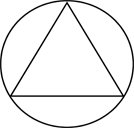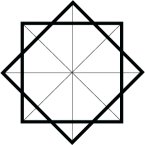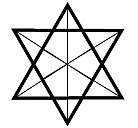For anyone here who is not clear on what these represent, the male triangle has a point in front, on the centerline in the direction one is facing. The female triangle has the triangle pointing towards the rear, so forward movement is angled off the centerline.
Conversely, in retreating the forward triangle moves offline, the female triangle moves in towards the center.
Both directions (forward and backward) are worth considering.
Most FMA schools emphasize the female triangle, yet the prototypical FMA symbol is represented by a male triangle inside a circle. Why this paradox, and what might it meaning?

Watching the Dog Brothers clips, what I noticed was how fights arrive at point of directness. Fighters may circle, looking to time an entry or snipe a peripheral shot on the fly, but at some point the aggressor takes control and goes after his opponent. Subtlety of angle is out; finishing is about taking it right at the other guy. Maybe my perception is skewed, but that’s how it generally appears to me. So how and why do different triangles theories work?
In talking about entries, it’s about setting up the position from where to attack. We can come straight in by defeating defenses or go around them to a less defended point. Theory often stresses the latter, but experience seems to favor the former.
I’ll start with the female triangle, as training it is more familiar to most people. It is useful in several ways. One can evade a direct attack while countering forward; it zones away from the opposite hand (unless one stays inside between the hands and simply opens up the stance, not my favorite concept) and it allows one to get to the opponent’s backside.
The male triangle has a different set of attributes. It can cut the opponent’s balance and energy by bisecting his baseline. Being direct gets point-to-point faster than longer circling, plus it more readily attacks vital targets on the centerline rather than the periphery. Taking the center redirects the opponent’s energy towards the outside of the circle while staying compact, like the hub of the wheel.
This is only for the forward direction of these triangles. Moving away from an opponent the qualities are reversed. The yin triangle pulls in towards the center, the male triangle steps outwards. People typically backpedal in a straight line when charged, as can be seen frequently in the Dog Brothers clips. It takes a bit more awareness to move offline effectively, a task made more difficult because a forward fast moving attacker may overwhelm one’s response, or be able to adapt so quickly as to re-align on his target.
This is a point frequently made by Marc “Animal” MacYoung in his seminars, where he demonstrates a realistic street attack as opposed to the kind of squared-off dueling practiced in many martial art schools. In the face of something that intense, shifting off the line of attack can be critical, and not everybody can do it well.
Is there a difference in a self-defense situation compared to a ring fight, even one as open as the Dog Brothers? Perhaps. In self-defense one may have an element of surprise on the part of either party. An attack could be a surprise, or perhaps the counter catches the attacker unawares. It is less likely that both parties are equally primed to fight or armed with similar weaponry. Thus there can be variable mismatches to overcome.
Ultimately the value of any footwork is positioning. Whether the goal is to get to an opponent’s weak spot or prevent him from finding yours, one has to have an awareness of these as prerequisite to any plan or strategy. The purpose of tactics is simply a means to an end, and as such it is limiting to think only of them in terms of a single triangle. I think it better to see them as a continuum within larger forms.
Consider that the angles of a triangle must add up to 180º. Many people step at a 45º angle on the female triangle, which works for largo counters at longer distance (mostly towards the limbs) but may veer too wide for deeper strikes or grapples. Entering from greater distance decreases deflective angle and vice versa. The tighter 60º angles of the FMA logo might be a more accurate roadmap for many applications. At closer range, one may need more angle of deflection, but then the counter angle back towards the center is a sharper turn.
A common training aid is to cross two lines in an “x”, creating both male and female triangles. Along with the lines, however, one can step to the quadrants thus formed, and those steps are like a “+”. This creates the “eight directions” which is a popular strategy of direction in Japanese and Korean martial arts, among others. Draw lines connecting the tips of the “x” and “+” shapes to form a square and diamond, and overlaid together these form an 8-pointed star, a common motif in Moslem art.
If you look at the inside lines, triangles are but half squares or rectangles. In this shape each triangle is a 90º angle and two 45º angles. Compare it to the 60º angles of the FMA logo above. That triangle, overlaid in male/female duality, creates a six pointed star, which creates a different pattern of movement. You can lay tape on the ground to practice stepping; each has it’s own logic and lessons to teach. Don’t you wish geometry had been this interesting in high school?
Don’t you wish geometry had been this interesting in high school?
No comments:
Post a Comment